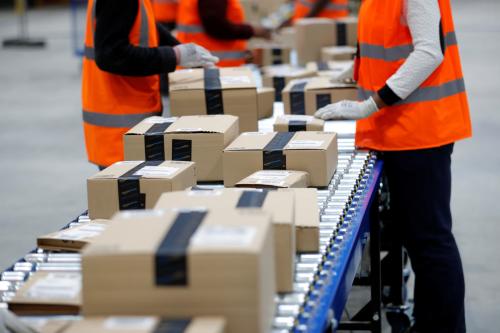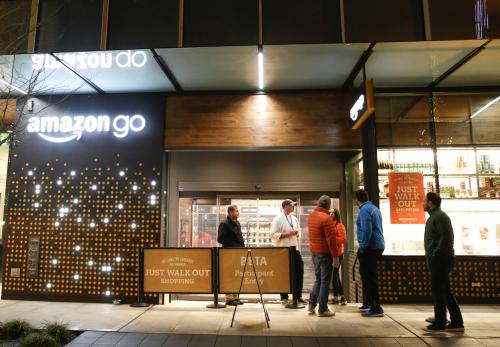The physical and digital retail worlds moved another step closer when Amazon’s concept convenience store Amazon Go opened to the public in January. Located near company headquarters in Seattle, the convenience store’s public launch comes one year after it opened for testing to Amazon employees. The store features an array of cameras that track purchases and automatically charge customers through a smartphone app. If the technology spreads to other stores, it may transition cashiers to other tasks within stores. Meanwhile, Amazon will collect a wealth of data about customers’ shopping habits from inside a brick-and-mortar store.
No barcode needed
Amazon Go eliminates the need for barcodes (and cashiers to scan them) by using sensors and cameras to track which items leave shelves with each customer. The technology could spell trouble for the 3.5 million U.S. workers employed as cashiers, but it might also transition them to other work around the store. A typical convenience store might employ as few as one employee per shift, yet Amazon Go employees check IDs for alcohol purchases, greet customers, answer questions, and stock items as soon as they deplete. Cameras and sensors tracking inventory and charging customers free up workers to focus on customer service. However, these tasks require a different set of skills than running a cash register. The introduction of new technology may not reduce the overall number of jobs in a store, but the tasks that make up remaining jobs will almost certainly change.
One could imagine a convenience store designed around automation: it might look something like the automats popular in the early 20th century, where customers pay for each item before removing it from a shelf. Rather than optimize store layout for machines, Amazon Go preserves a traditional store layout minus the checkout counters. Store cameras can observe movement from above while shoppers browse. Shoppers have noted the “just walk out” experience feels like shoplifting, but little else has changed. Deploying new technology within a familiar setting may be the key to its widespread adoption.
Fewer cash registers, more data
Amazon has not offered many specifics on how their technology works except to say it is similar to driverless cars, which use sensors to create a real-time digital model of a roadway. Likewise, cameras and other sensors must create a digital model of the store that updates in real-time as items and shoppers move around the store. Algorithms then sort through streams of data to match different shapes in the digital model to people and customers in the real world. The store may act as a proof of concept for Amazon’s own technology research and development, but it remains unclear if other stores would go to similar lengths to automate the checkout process.
Compared to scanning barcodes, using artificial intelligence to track items is an extremely data-intensive method of tracking inventory. However, increasing data collection more than increasing sales may be the ultimate goal. The e-commerce giant already track every click made on its website and uses that information to make changes based on click patterns. With a similar level of data about in-store customers, Amazon could learn more about customer habits while they are shopping. How quickly did they find what they were looking for? Other stores rely on customer rewards programs to track customer purchases in exchange for discounts. With Amazon Go, the tech company can offer the convenience of simply walking out with purchases in exchange for a wealth of data on customer behavior.
Amazon Go applies the experience of an e-commerce website to a brick-and-mortar store. In e-commerce, software handles transactions and algorithms return search results and make product recommendations. An employee might intervene only to answer a question about a product or to resolve a problem with an order. The physical manifestation of this model fundamentally changes the retail experience for customers and retail employment for workers. As of 2016, the retail sector employed 10 percent of the American workforce, but that may change if stores adopt technology that makes retail workers more efficient. Customers will have to decide whether to accept a level of data collection once only possible in e-commerce.
Amazon is a donor to the Brookings Institution. The findings, interpretations, and conclusions posted in this piece are solely those of the authors and not influenced by any donation.
The Brookings Institution is committed to quality, independence, and impact.
We are supported by a diverse array of funders. In line with our values and policies, each Brookings publication represents the sole views of its author(s).









Commentary
Amazon Go store offers quicker checkout for greater data collection
February 13, 2018